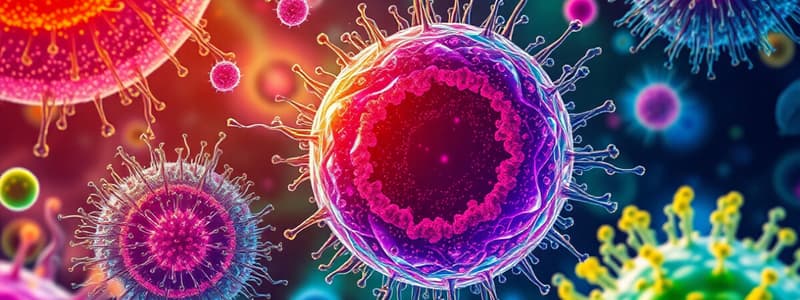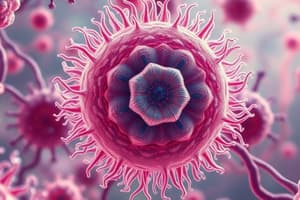Podcast
Questions and Answers
What characteristic distinguishes eukaryotic cells from prokaryotic cells?
What characteristic distinguishes eukaryotic cells from prokaryotic cells?
- Defined nucleus and membrane-bound organelles (correct)
- Size of the cell
- Location of genetic material in nucleoid region
- Presence of ribosomes
Which organelle is primarily responsible for ATP production?
Which organelle is primarily responsible for ATP production?
- Mitochondria (correct)
- Chloroplast
- Endoplasmic reticulum
- Golgi apparatus
Which phase of mitosis is characterized by the alignment of chromosomes in the center of the cell?
Which phase of mitosis is characterized by the alignment of chromosomes in the center of the cell?
- Prophase
- Anaphase
- Metaphase (correct)
- Telophase
Which type of transport mechanism requires energy to move substances across the cell membrane?
Which type of transport mechanism requires energy to move substances across the cell membrane?
What is the primary function of the endoplasmic reticulum (smooth ER)?
What is the primary function of the endoplasmic reticulum (smooth ER)?
What is the role of the Golgi apparatus in the cell?
What is the role of the Golgi apparatus in the cell?
Which of the following processes describes the breaking down of molecules within the cell?
Which of the following processes describes the breaking down of molecules within the cell?
In which type of cells does photosynthesis primarily take place?
In which type of cells does photosynthesis primarily take place?
Which statement best describes the function of ribosomes?
Which statement best describes the function of ribosomes?
What does the discovery of the cell theory state?
What does the discovery of the cell theory state?
Flashcards are hidden until you start studying
Study Notes
Cell: The Unit of Life
Definition of a Cell
- Basic structural and functional unit of all living organisms.
- Cells can exist as unicellular (single-celled) or multicellular (many-celled) organisms.
Types of Cells
-
Prokaryotic Cells:
- Lack a defined nucleus.
- Typically smaller and simpler (e.g., bacteria and archaea).
- Genetic material is located in a nucleoid region.
-
Eukaryotic Cells:
- Have a defined nucleus and membrane-bound organelles.
- Generally larger and more complex (e.g., plant, animal, fungi, and protist cells).
- Organelles include mitochondria, endoplasmic reticulum, Golgi apparatus, etc.
Cell Structure
-
Cell Membrane:
- Phospholipid bilayer that controls the movement of substances in and out of the cell.
-
Cytoplasm:
- Gel-like substance where cellular processes occur and organelles are suspended.
-
Nucleus:
- Contains genetic material (DNA); controls cell activities.
-
Organelles:
- Mitochondria: Powerhouse of the cell; site of ATP production.
- Chloroplasts (in plants): Site of photosynthesis.
- Ribosomes: Synthesize proteins.
- Endoplasmic Reticulum:
- Rough ER: Has ribosomes; involved in protein synthesis and processing.
- Smooth ER: Lacks ribosomes; involved in lipid synthesis and detoxification.
- Golgi Apparatus: Modifies, sorts, and packages proteins and lipids for secretion.
Cell Division
-
Mitosis:
- Process of cell division resulting in two identical daughter cells.
- Phases: Prophase, Metaphase, Anaphase, Telophase, and Cytokinesis.
-
Meiosis:
- Production of gametes (sperms and eggs); results in four genetically diverse cells.
- Involves two rounds of division.
Cellular Processes
-
Metabolism:
- Sum of all chemical reactions within a cell, including catabolism (breaking down molecules) and anabolism (building up molecules).
-
Cell Communication:
- Cells communicate through signaling molecules; receptors on target cells receive signals.
-
Transport Mechanisms:
- Passive Transport: Movement across the cell membrane without energy (e.g., diffusion, osmosis).
- Active Transport: Movement against a concentration gradient requiring energy (e.g., sodium-potassium pump).
Importance in Biology
- Understanding cells is crucial for studies in genetics, microbiology, physiology, and health sciences.
- Discovery of the cell theory: all living organisms are composed of cells, which are the basic units of life.
Cell: The Unit of Life
- The fundamental building block of all living organisms.
- Exists in two forms: unicellular (single-celled) and multicellular (many-celled).
Types of Cells
- Prokaryotic Cells:
- Lack a defined nucleus.
- Smaller and simpler than eukaryotic cells.
- Examples include bacteria and archaea.
- Genetic material exists within a nucleoid region.
- Eukaryotic Cells:
- Contain a defined nucleus and membrane-bound organelles.
- Typically larger and more complex than prokaryotic cells.
- Examples include plant, animal, fungi, and protist cells.
- Specialized organelles, such as mitochondria, endoplasmic reticulum, and Golgi apparatus, perform different functions.
Cell Structure
- Cell Membrane:
- Phospholipid bilayer that regulates the passage of substances in and out of the cell.
- Cytoplasm:
- Gel-like substance where cellular processes occur and organelles are suspended.
- Nucleus:
- Contains the cell's genetic material (DNA).
- Controls cellular activities.
- Organelles:
- Mitochondria:
- Powerhouse of the cell.
- Site of ATP (energy) production.
- Chloroplasts (plants):
- Site of photosynthesis.
- Responsible for converting sunlight into energy.
- Ribosomes:
- Synthesize proteins.
- Essential for cellular function.
- Endoplasmic Reticulum:
- Rough ER: Contains ribosomes.
- Involved in protein synthesis and processing.
- Smooth ER: Lacks ribosomes.
- Involved in lipid synthesis and detoxification.
- Rough ER: Contains ribosomes.
- Golgi Apparatus:
- Modifies, sorts, and packages proteins and lipids for secretion.
- Mitochondria:
Cell Division
- Mitosis:
- Process of cell division that produces two identical daughter cells.
- Four stages:
- Prophase
- Metaphase
- Anaphase
- Telophase
- Cytokinesis completes the division.
- Meiosis:
- Production of gametes (sperm and egg cells), resulting in four genetically unique cells.
- Two rounds of division occur.
Cellular Processes
- Metabolism:
- Sum of all chemical reactions within a cell.
- Catabolism: Breaking down molecules.
- Anabolism: Building up molecules.
- Sum of all chemical reactions within a cell.
- Cell Communication:
- Cells communicate through signaling molecules.
- Receptors on target cells receive signals.
- Transport Mechanisms:
- Passive Transport:
- Movement of substances across the cell membrane without requiring energy.
- Examples include diffusion and osmosis.
- Active Transport:
- Movement against a concentration gradient, requiring energy.
- Example: Sodium-potassium pump.
- Passive Transport:
Importance in Biology
- Understanding cells is fundamental to many biological fields.
- Genetics
- Microbiology
- Physiology
- Health Sciences
- The discovery of the cell theory revolutionized biology.
- All living organisms are composed of cells.
- Cells are the basic functional unit of life.
Studying That Suits You
Use AI to generate personalized quizzes and flashcards to suit your learning preferences.




